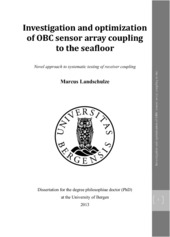Investigation and optimization of OBC sensor array coupling to the seafloor: Novel approach to systematic testing of receiver coupling
Doctoral thesis
Date
2013-10-29Metadata
Show full item recordCollections
- Department of Earth Science [1096]
Abstract
The most important challenge for the oil-industry is to increase the recovery rates for existing oil and gas fields and to map fluid movements with time-lapse 4D seismic, ensure caprock integrity and reduce geo-hazards or to monitor CO2 storage in an offshore reservoir by using active and passive sources (e.g. Airgun-survey and passive seismic/microseismic). The common seismic equipment is configured in receiver lines with cables trenched or covered on the sea-bottom. The equipment typically comprises up to 4000 receivers depending on the aerial extent of the reservoir. Multicomponent receiver technology like Ocean Bottom Cable (OBC), borehole tools or Ocean Bottom Nodes (OBN) provides information on both pressure and particle velocity recorded with three component accelerometers or geophones and an omnidirectional hydrophone at the seafloor level, allowing complementary PP and PS imaging. In order to improve the 4C seismic processing by reducing noise and perform high accurate shear-wave measurements, it is important to understand the coupling of a receiver array to the seafloor. This thesis is focusing on several aspects of receiver coupling to the seafloor by presenting two developed methods on how to measure coupling and how to estimate receiver performance or vector fidelity (paper 1 and 2). The results from these methods are used to simulate receiver coupling by using finite element methods (software tool Multiphysics) to investigate the full waveform outside the receiver housing (paper 3). During my research I discovered different responses of seismic signals depending on the azimuth between the receiver and the source (paper 4). I thus investigated measured data and compared it with synthetic/simulated data and developed one possible explanation to why receiver coupling is azimuth depending.
Has parts
Paper 1: Landschulze, M, Mjelde, R. (2013): “Horizontal OBC coupling to sediment; an iterative method to estimate coupling parameters.” Full-text not available.Paper 2: Landschulze, M, Mjelde, R. (2013): “Qualitative seismic receiver array performance and coupling estimation, a method using ambient noise.” Full-text not available.
Paper 3:Landschulze, M, Mjelde, R., Landschulze, K. (2013): “Systematic simulation of multicomponent receiver coupling to the seafloor; using rheological models.” Full-text not available.
Paper 4:Landschulze, M, Mjelde, R. (2013): “Azimuth-dependent OBC receiver coupling to the seafloor.” Full-text not available.
